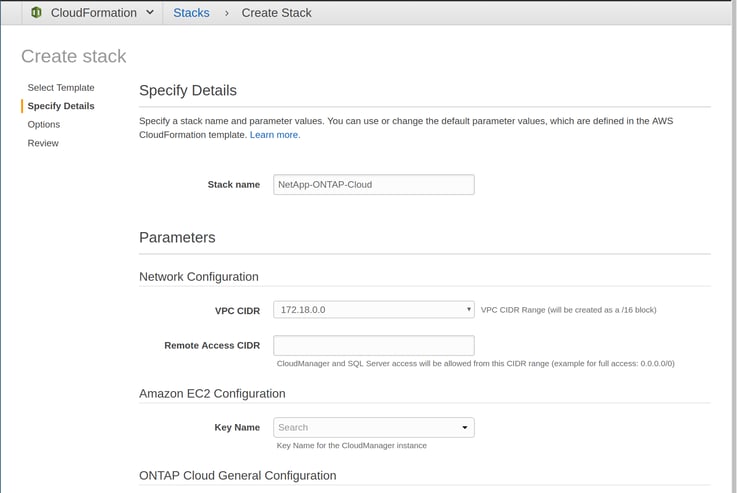Subscribe to our blog
Thanks for subscribing to the blog.
July 26, 2017
Topics: Cloud Volumes ONTAP AWS5 minute read

AWS Quick Starts eliminate the manual effort required to deploy new stacks in AWS, stacks you might use for proof of concept efforts, or quickly deploying new production resources.
They differ from launching Amazon Machine Images directly by catering to customized and more intricate deployments that may involve systems from multiple vendors. Since they’re created by experts in AWS solutions architecture, Quick Starts always adhere to best practices for security, networking, and high availability.
NetApp is now introducing AWS Quick Starts for Cloud Volumes ONTAP to help get you started.
The first available Quick Start sets up a Microsoft SQL Server 2014 environment complete with separate iSCSI storage allocations for enterprise class of your data and logs.
In this article, we will take an in-depth look at using this Quick Start and the many benefits of using SQL Server together with Cloud Volumes ONTAP.
Quick Start: Microsoft SQL Server
Setting up SQL Server with SAN storage requires installation and configuration of both the database server and the Cloud Volumes ONTAP system. On the storage side, this involves:
- Deploying and configuring OnCommand Cloud Manager, which is used to launch and manage instances of Cloud Volumes ONTAP.
- Creating a new instance of Cloud Volumes ONTAP in AWS.
- Allocating new storage volumes to be used by the database.
- Creating LUNs for database data and database log files per NetApp best practices
- Configuring iSCSI for connections between the database server and the Cloud Volumes ONTAP system
For the database server, a Windows Server machine is required to host SQL Server. The Quick Start uses a standard AWS Marketplace AMI of Windows Server 2012 R2 with SQL 2014 Standard.
This machine is then connected to the LUNs from the NetApp cloud-based SAN environment using iSCSI. The SQL Server can now use the data and log LUNs provided by the Cloud Volumes ONTAP system for placement of its respective database files.
NetApp’s new AWS Quick Start allows you accomplish all of this with just a few clicks, with the ability to configure Cloud Volumes ONTAP, SQL Server, and the networking setup along the way.
The Quick Start can either be deployed into a new VPC (Virtual Private Cloud) or an existing one.

Quick Starts make use of AWS CloudFormation templates to define compute, storage, networking, and other resources that must be provisioned in order to create the environment. These templates can be fully customized, which means you can use them in CloudFormation Designer as a starting point for your own builds.

While the Quick Start is executing, you can monitor its progress through the Events tab in the AWS CloudFormation console.
After the Quick Start finishes launching, you can verify the installation by accessing the Windows Server 2012 instance via a remote desktop connection. Once there, you’ll see the two iSCSI LUNs from Cloud Volumes ONTAP mounted as additionally connected disks that you can now use with your SQL Server using the Microsoft client tools to start working with the database.

As another form of verification you can also connect to OnCommand Cloud Manager and review the installation of Cloud Volumes ONTAP from the main dashboard.
From here, you can choose to manage all of your Cloud Volumes ONTAP installations in one place. This includes the deployment of new instances of Cloud Volumes ONTAP as well as relationships with on-premises appliances. For new instances of Cloud Volumes ONTAP, Cloud Manager takes care of allocating all AWS resources and guides you through the deployment process with a single, intuitive wizard.
After logging into Cloud Manager, you’ll find the dashboard graphically displays your instance of Cloud Volumes ONTAP, allowing you to view configuration information and to perform various actions, such as volume creation.
You can also review the volumes that were created to support the database environment.

With your database storage now hosted on Cloud Volumes ONTAP, you gain the following advantages:
- Storage efficiencies: Cloud Volumes ONTAP uses a number of technologies that transparently reduce your storage footprint, such as data compression, which works especially well with database files. Other such features include deduplication and inline data compaction. Thin provisioning can also be used to only allocate storage when it’s actually required, which is also very useful in database environments. Using less cloud storage lowers your total operating costs.
- Instant backup and restore: In addition to native SQL Server backups, you can also use ONTAP Snapshots to backup your data, which instantaneous and more space efficient than Amazon EBS snapshots. Optionally, you can also use NetApp SnapCenter which provides a plugin for Microsoft SQL Server. This means that you can easily and repeatedly create application-consistent snapshot backups instantly for source data of any size. Restoring from these backups is also instantaneous.
- Database clones: FlexClone is an awesome feature for database administrators and DevOps engineers that need to create temporary copies of production databases, either for system testing or software development.
FlexClone lets you instantly create a storage efficient, writable replica of an existing volume of any size. The replica essentially requires no additional storage and only allocates blocks when data in the clone actually changes.
- Advanced LUN management: Cloud Volumes ONTAP provides many features to centrally manage your iSCSI storage allocations. For example, if a database LUN needs to be moved between storage tiers, it can be kept online during the move, with subsequent writes going directly to the new destination. The LUN move can also be paused and resumed, as needed.
- Storage replication: With features such as SnapMirror and SnapVault, you can easily mirror or backup your database storage to other instances of Cloud Volumes ONTAP, using efficient, mature, and enterprise-grade technology.
Summary
NetApp’s introduction of AWS Quick Starts helps users to create reference environments using Cloud Volumes ONTAP without needing to perform all of the manual setup and configuration.
This helps to save a lot of time, whether you need to perform a proof of concept or are looking for a base build on that you can further customize.
Try the Quick Start for yourself with the free trial of Cloud Volumes ONTAP.
